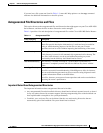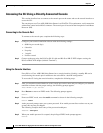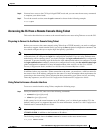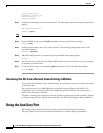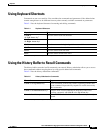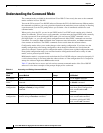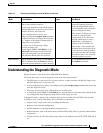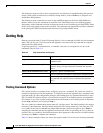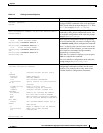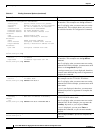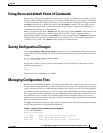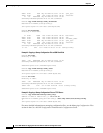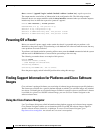
2-7
Cisco ASR 1000 Series Aggregation Services Routers Software Configuration Guide
OL-16506-17
Chapter 2
Understanding the Diagnostic Mode
Understanding the Diagnostic Mode
Diagnostic mode is new on the Cisco ASR 1000 Series Routers.
The router boots up or accesses diagnostic mode in the following scenarios:
• The IOS process or processes fail, in some scenarios. In other scenarios, the RP will simply reset
when the IOS process or processes fail.
• A user-configured access policy was configured using the transport-map command that directs the
user into diagnostic mode.
• The router was accessed using a Route Processor auxiliary port.
• A send break signal (Ctrl-C or Ctrl-Shift-6) was entered while accessing the router, and the router
was configured to enter diagnostic mode when a break signal was sent.
In diagnostic mode, a subset of the commands that are also available in User EXEC mode are made
available to users. Among other things, these commands can be used to:
• Inspect various states on the router, including the IOS state.
• Replace or roll back the configuration.
• Provide methods of restarting the IOS or other processes.
• Reboot hardware, such as the entire router, an RP, an ESP, a SIP, a SPA, or possibly other hardware
components.
• Transfer files into or off of the router using remote access methods such as FTP, TFTP, SCP, and so
on.
Diagnostic The router boots up or accesses diagnostic
mode in the following scenarios:
In some cases, diagnostic mode will be reached
when the IOS process or processes fail. In most
scenarios, however, the router will.
A user-configured access policy was
configured using the transport-map command
that directed the user into diagnostic mode. See
the “”chapter of this book for information on
configuring access policies.
The router was accessed using a Route
Processor auxiliary port.
A break signal (Ctrl-C, Ctrl-Shift-6, or the
send break command) was entered and the
router was configured to go into diagnostic
mode when the break signal was received.
Router(diag)#
If the IOS process failing is the
reason for entering diagnostic
mode, the IOS problem must be
resolved and the router rebooted to
get out of diagnostic mode.
If the router is in diagnostic mode
because of a transport-map
configuration, access the router
through another port or using a
method that is configured to
connect to the Cisco IOS CLI.
If the router is accessed through
the Route Processor auxiliary port,
access the router through another
port. Accessing the router through
the auxiliary port is not useful for
customer purposes anyway.
ROM monitor From privileged EXEC mode, use the reload
EXEC command. Press the Break key during
the first 60 seconds while the system is booting.
>
To exit ROM monitor mode, use
the continue command.
Table 2-3 Accessing and Exiting Command Modes (continued)
Command
Mode Access Method Prompt Exit Method



